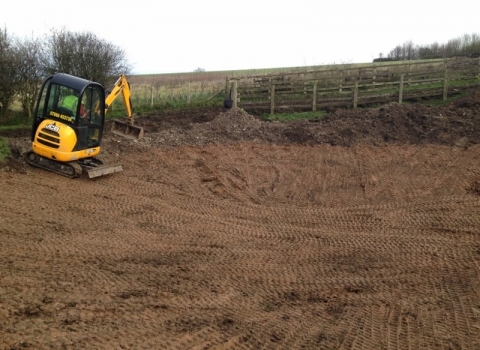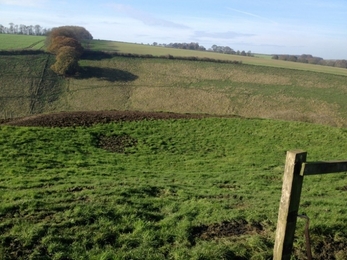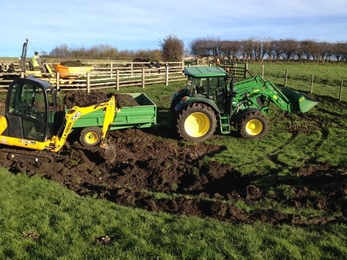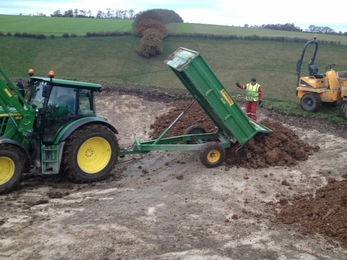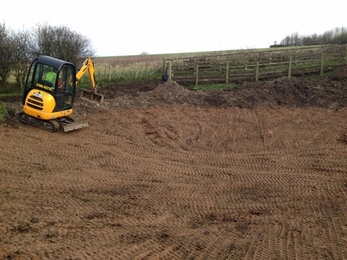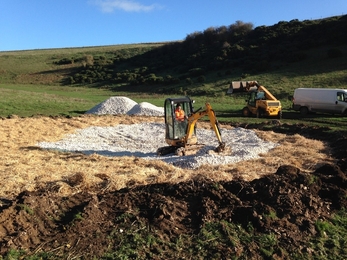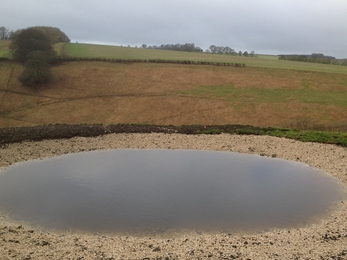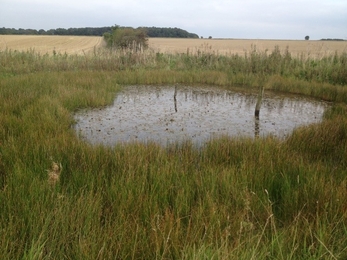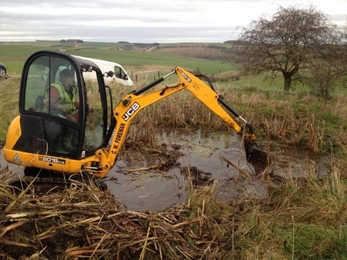Discover how to restore and manage dew ponds
Some ponds require a full restoration before they can thrive once again, and all dew ponds need ongoing management. This helps to ensure that they remain healthy, wet environments.
Restoring dew ponds
1) Remove silt
Firstly, the build-up of silt and the original layer of stone needs to be removed. This reveals the pond base. In the Wolds the pond base tends to be either hard lime and sand plaster or clay.
2) Install pond liner
Once the original pond base has been revealed, you may need to add an additional pond layer.
If the pond base is made from lime then the clay layer (see step 3) can sit directly on top of it. The lime acts as a barrier for earth worms which otherwise would penetrate the clay.
If the pond base is not made from lime, then another barrier is required. This can be either old carpet or sheets of weed membrane.
3) Cover with clay
The clay can then be tipped into the pond and spread out before 'puddling' begins.
Puddling involves driving a small 360 excavator back and forth across the pond compressing the clay to create a plasticine-like consistency. It is important that the clay isn’t too wet and the weather conditions are fine. You can add water to drier clay using a watering can to get the right consistency.
Puddling two layers of clay gives a good waterproof layer. The clay liner should be between 6 and 8 inches thick. An average size pond - 12 x 12m - will require approximately two loads of clay. This is approximately 18 tonnes.
4) Add wheat straw and stone
Once the clay is ready a layer of wheat straw is laid down against the clay. A final layer of stone is then placed over the straw to further protect the clay from drying and also provide protection from the feet of farm animals. Chalk is the most usual material in the Wolds.
Depending on the weather and time of year, the ponds can then be left to naturally fill with rainwater. If dry weather is forecast and you are able to, you can fill the ponds with mains water.
Managing dew ponds
Every few years the dew ponds require sensitive management to prevent the natural process of them filling with silt and vegetation.
If left unmanaged the ponds will slowly dry out. The ponds that are situated in areas where there are farm animals grazing tend to be less prone to filling up with plants. However, silt can still build up over time.
The best way to manage a pond is to carry out work little and often which avoids extreme, sudden changes to the habitat.
For smaller jobs plants can be removed by hand with a rake but often using a small 360 excavator is a more practical option for removing vegetation and silt build-up.
Using a 360 excavator rather than a telehandler reduces the risk of damaging the clay liner. Often the pond liners are only a few inches thick so care must be taken not to damage this layer.
Top tips for managing a dew pond:
- Carry out works in autumn/winter to avoid breeding amphibians and birds
- Remove no more than one third of the vegetation or silt
- Aim to create a mosaic of habitat with areas of open water, emergent vegetation like rushes or reeds and submerged vegetation like aquatic mosses and broadleaved pondweed.
- Do not introduce any plants or animals (especially fish) to the pond.
- Leave material on the pond edge for at least 24 hours so that creatures can find their way back to the water
- Carefully scrap the silt and vegetation from the base of the pond without digging into the liner
- If you see stone in the bucket you have gone deep enough
Other factors to consider:
- Allow the water to naturally draw down in drier months
- Only add water during prolonged drought to protect the clay lining from cracking
- Prevent pollutants from entering the pond, including spray drift and fertilisers
- Do not allow tree or shrub roots to damage the pond liner
- Provide a 6m buffer strip between the pond and arable land to protect from spray drift, slow runoff and provide terrestrial habitat

